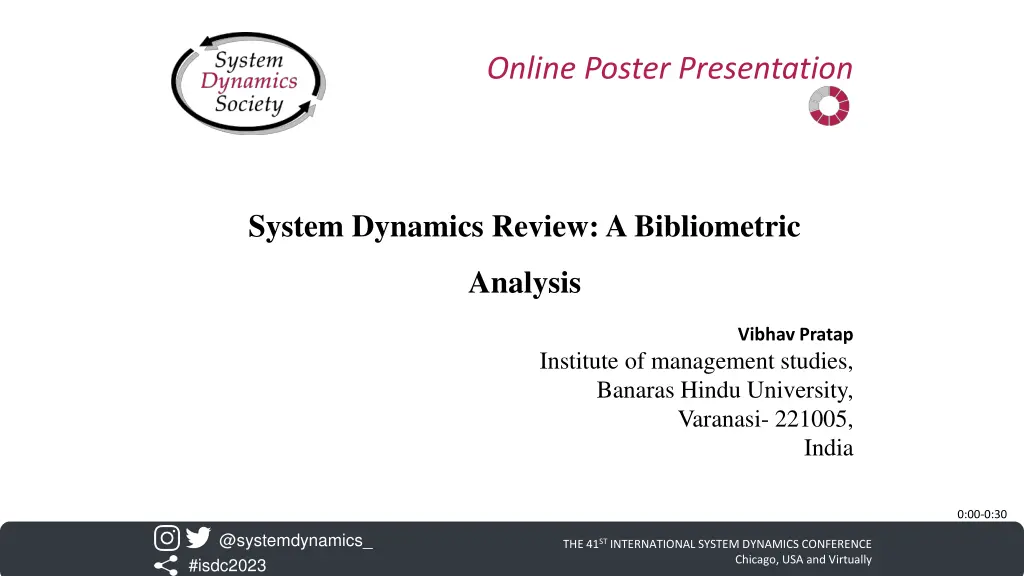
Bibliometric Analysis of System Dynamics Review: Key Insights and Impact
Explore the bibliometric study analyzing System Dynamics Review journal, delving into its impact factor, citation patterns, and authorship characteristics. Gain valuable insights for researchers and the system dynamics community, identifying emerging research areas and collaborative opportunities in the field.
Download Presentation

Please find below an Image/Link to download the presentation.
The content on the website is provided AS IS for your information and personal use only. It may not be sold, licensed, or shared on other websites without obtaining consent from the author. If you encounter any issues during the download, it is possible that the publisher has removed the file from their server.
You are allowed to download the files provided on this website for personal or commercial use, subject to the condition that they are used lawfully. All files are the property of their respective owners.
The content on the website is provided AS IS for your information and personal use only. It may not be sold, licensed, or shared on other websites without obtaining consent from the author.
E N D
Presentation Transcript
Online Poster Presentation System Dynamics Review: A Bibliometric Analysis Vibhav Pratap Institute of management studies, Banaras Hindu University, Varanasi- 221005, India 0:00-0:30 @systemdynamics_ #isdc2023 THE 41ST INTERNATIONAL SYSTEM DYNAMICS CONFERENCE Chicago, USA and Virtually
Problem Statement The problem that this bibliometric study is addressed to investigate and evaluate the System Dynamics Review journal by employing bibliometric techniques to determine its impact factor, citation patterns, authorship characteristics, and collaboration networks. By conducting an in-depth analysis of this journal, the study aims to provide valuable insights for researchers and the system dynamics community, facilitating the assessment of the journal's standing within the field, identification of emerging research areas, and enhancement of collaborative opportunities. 0:30-2:00 @ systemdynamics_ THE 41ST INTERNATIONAL SYSTEM DYNAMICS CONFERENCE THE 40TH INTERNATIONAL SYSTEM DYNAMICS CONFERENCE #isdc2022 #isdc2023 Chicago, USA and Virtually Virtually everywhere!
Approach or Dynamic Hypothesis Bibliometrics is the use of statistical techniques and numerical tools to analyze bibliographical data (Pritchard 1969) The study uses VOS viewer to examine SDR publications published between 1985 and 2022 based on bibliographic coupling and keyword cooccurrences A bibliometric technique consists of (i) quantitative measures to gauge productivity, (ii) qualitative indicators to gauge the effect and (iii) structural measures to gauge the relationship and interactions between the scientific players (Valerie Durieux, 2010) Similar to this, Cobo et al. (2011) point out that there are often two approaches to bibliometric analysis: performance analysis and science mapping analysis. Performance analysis discusses descriptive analysis, the output of scientific work, while science mapping analysis is concerned with showing the structural and dynamic elements of the research cycle or scientific inquiry. In conclusion, the use of both approaches together yields a comprehensive picture of a particular actor's profile in the research domain. 2:00-3:30 @systemdynamics_ THE 41ST INTERNATIONAL SYSTEM DYNAMICS CONFERENCE THE 40TH INTERNATIONAL SYSTEM DYNAMICS CONFERENCE #isdc2022 #isdc2023 Chicago, USA and Virtually Virtually everywhere!
Results SDR's publication performance has remained stable over the last two decades, but its citations have declined. Topics including "system analysis," "modelling," and "numerical modelling" have become more popular. The key issues covered by SDR fall into four broad groups: Modelling approach, computer simulations, and numerical model; Teaching, research, and performance evaluation; Optimization, parameterization and algorithm; and Eurasia and Europe Conclusions, The most often cited works have significantly advanced three important fields: group model building, model testing, model validity, and formal methods, and modeling dynamic issues with large applicability. The SDR role is very crucial and the development of the system dynamics discipline is emphasized in this bibliometric study Recommendations There are three topics that appear to be worthy of further investigation and future study. 1. Behaviroul research 2. System dynamics capacity to measuring the effects of interventions in the long spam: 3. Improving elicitation methods for people that are novices to system dynamics: 1. 2. 3. 4. 3:30-5:00 @systemdynamics_ THE 41ST INTERNATIONAL SYSTEM DYNAMICS CONFERENCE THE 40TH INTERNATIONAL SYSTEM DYNAMICS CONFERENCE #isdc2022 #isdc2023 Chicago, USA and Virtually Virtually everywhere!
